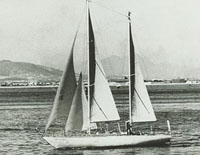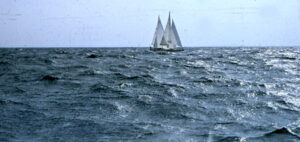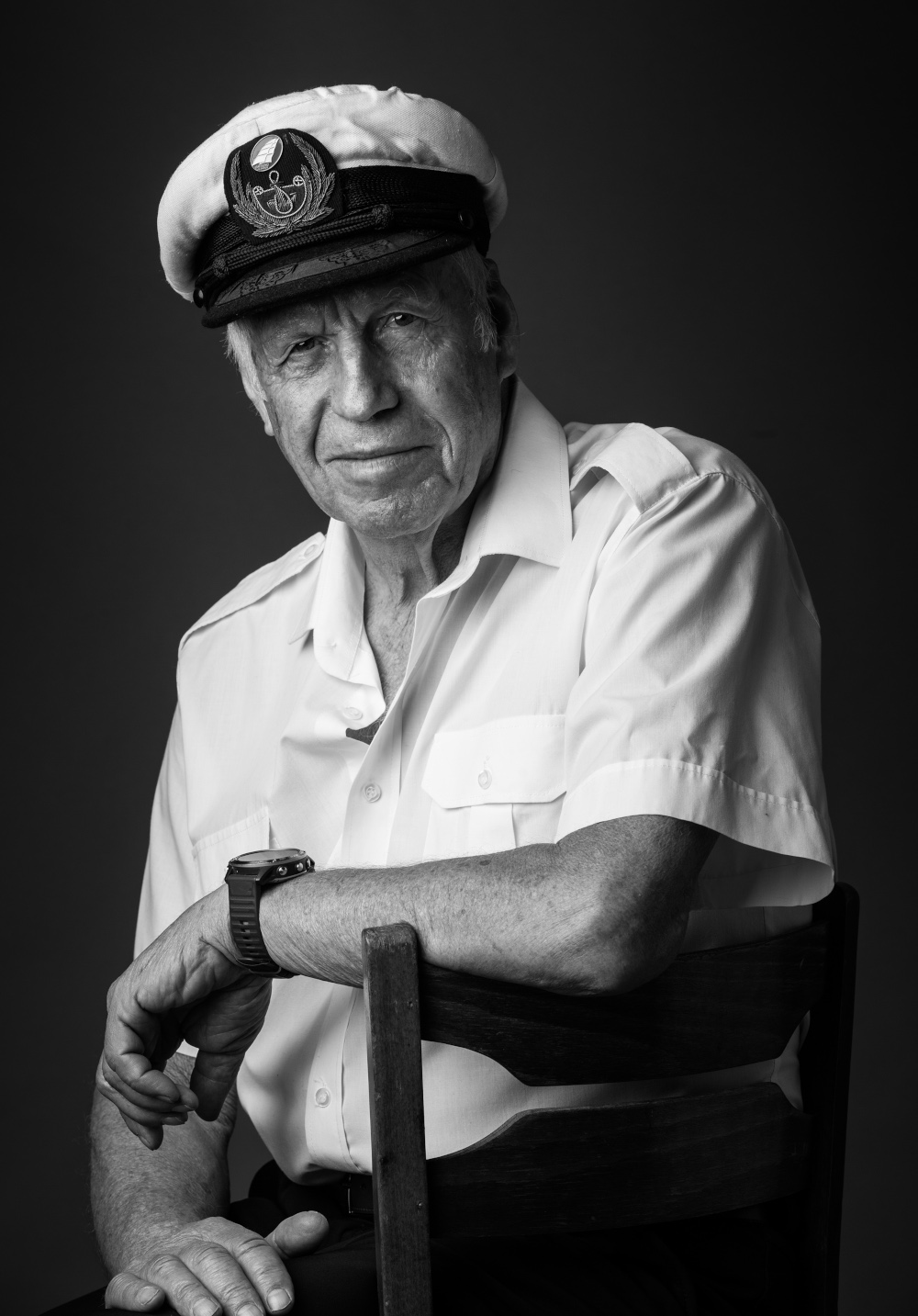 Udany start w regatach przez Atlantyk zachęcił mnie do płynięcia dalej. Najwyraźniej żegluga samotna mi służyła. Postanowiłem wrócić „Polonezem” do domu, ale płynąc dookoła świata i wybierając ambitną trasę na wschód. Trasa na wschód to praktycznie rejs dookoła Antarktydy w tzw. Ryczących Czterdziestkach, to znaczy w szerokościach południowych rzędu 40 stopni, w których to szerokościach silne wiatry ryczały w takielunku dawnych żaglowców. Tylko w tej części globu świat dokoła nieprzerwanie oblewa woda, ale też z powodu tej wielkiej otwartej przestrzeni tutaj spotyka się niezwykłej wysokości fale.
Udany start w regatach przez Atlantyk zachęcił mnie do płynięcia dalej. Najwyraźniej żegluga samotna mi służyła. Postanowiłem wrócić „Polonezem” do domu, ale płynąc dookoła świata i wybierając ambitną trasę na wschód. Trasa na wschód to praktycznie rejs dookoła Antarktydy w tzw. Ryczących Czterdziestkach, to znaczy w szerokościach południowych rzędu 40 stopni, w których to szerokościach silne wiatry ryczały w takielunku dawnych żaglowców. Tylko w tej części globu świat dokoła nieprzerwanie oblewa woda, ale też z powodu tej wielkiej otwartej przestrzeni tutaj spotyka się niezwykłej wysokości fale.


My successful accomplishment of the trans-Atlantic race encouraged me to sail even further. It seemed that sailing single-handed served me well. I wanted to get back home on “Polonez”, but I decided to take the more ambitious route round the world eastward. This route is nearly equal to a voyage round Antarctica in the so called Roaring Forties; the area between the latitudes of 40 and 50 degrees, where strong winds used to roar in the rigging of old sailing vessels.It is only in this part that water circumfuses the Earth unstopped.

Die ziemlich erfolgreiche Teilnahme an der Atlantik-Regatta hatte mich dazu motiviert, weiter zu segeln. Offensichtlich hat das Alleinsegeln bei mir keinen Schaden hinterlassen. Ich habe mich dazu entschieden, mit der Polonez nach Hause zurückzukehren – aber über Umwege rund um den Globus. Ich wählte die anspruchsvolle Strecke von Westen nach Osten, so dass ich über die Antarktis und die Region der Roaring Forties (Brüllender Vierziger) fahren würde. Dabei handelt es sich um ein Gebiet zwischen 40° und 50°südlicher Breite, in dem starke Winde wehen und die Masten alter Segelschiffe zerfetzen.

Удачное выступление в атлантической гонке побудило меня плыть дальше. Одиночное мореходство явно было мне по душе. Я решил вернуться домой на «Полонезе», но вокруг света, избрав для этого восточный маршрут. Путь на восток – это практически рейс вокруг Антарктики, по так называемым «ревущим сороковым», то есть, по южным широтам порядка 40 градусов, где сильные ветры рычали в такелаже старых парусников.
Żeby zejść „na dół” na południe startując z północnych Stanów Zjednoczonych trzeba wykonać wielkie „S” wygięte w stronę Azorów i Wysp Zielonego Przylądka jednym brzuszkiem, a w stronę Brazylii i Argentyny drugim brzuszkiem, po prostu tak układają się wiatry na obu półkulach. Ten odcinek do Kapsztadu zrobiony jednym skokiem zajął mi 60 dni. Drugi skok do Australii 53 dni, trzeci do Falklandów tuż za Przylądkiem Horn 45 i czwarty Atlantykiem do Plymouth 75 dni. Łatwo się to mówi…

Wyjście z Kapsztadu
Zgodnie ze swoją sławą Ryczące Czterdziestki pokazały swoją siłę. Przy wiatrach sztormowych zmieniających swój kierunek razem z przechodzącymi niżami wzajemnie ze sobą interferujące fale powodowały takie zjawiska jak wypiętrzanie się mas wody w formie piramidy stojącej na wierzchołku czy zapadanie się dolin fali w potworne dziury. Na Oceanie Indyjskim „Polonez” został zrolowany na grzbiecie fali, samoster zniszczony, maszt pogięty. Liżąc rany w Hobart na Tasmanii zastanawiałem się czy można tak ryzykować i płynąć dalej.
Dzisiaj się cieszę, że nie dałem się namówić na przerwanie rejsu. Okrążyłem Przylądek Horn przy względnie dobrej pogodzie i wpisałem się na ekskluzywną listę samotnych żeglarzy, którzy opłynęli świat w Ryczących Czterdziestkach. W owym czasie, czyli w roku 1973 było ich zaledwie 8 – jeden Argentyńczyk, Vito Dumas płynął w latach czterdziestych, a potem w latach sześćdziesiątych 6 Anglików – Francis Chichester, Alec Rose, Robin Knox-Johnston, Nigel Tetley, Chay Blyth i Bill King oraz jeden Francuz Bernard Moitessier.
Bill King kończył swój samotny rejs w Plymouth, zaledwie dwa dni przede mną. Przyjęcie jakie zgotowali mi Brytyjczycy w Plymouth nie odbiegało od tego co zgotowali swojemu rodakowi. Pokłosie literackie rejsu: książki „Polonezem dookoła świata”, ”Droga na Horn” i album „Polonez”.
Because of this immense open space the waves there are extremely high and in order to 'move’ down south from the USA, a sailor has to take an S-shape route. It firstly bends towards the Azores and the Cape Verde Islands and then unwinds toward Brazil and Argentina as this is the way the winds blow. The first leg to Cape Town took me 60 days, the second to Australia -53 days, the third to Cape Horn- 45 days and the last one to Plymouth -75 days. It is easier said than done…The Roaring Forties showed their power. Hurricane winds were constantly  changing their direction. The waves were forming reverse pyramids or enormous valley-shaped hollows. On the Indian Ocean “Polonez” rolled right over on a wave, her self-steering gear broke and the mast was bent. When repairing the yacht in Hobart on Tasmania I was questioning whether it was worthwhile taking the risk of sailing any further. I am so glad that I did not take any advice to stop. I rounded Cape Horn in relatively good weather
changing their direction. The waves were forming reverse pyramids or enormous valley-shaped hollows. On the Indian Ocean “Polonez” rolled right over on a wave, her self-steering gear broke and the mast was bent. When repairing the yacht in Hobart on Tasmania I was questioning whether it was worthwhile taking the risk of sailing any further. I am so glad that I did not take any advice to stop. I rounded Cape Horn in relatively good weather  and joined the prestigious list of sailors who have circumnavigated the Earth in the Roaring Forties. Back then there were only 8 people who had managed that; one Argentinian- Vito Dumas in the 40’s, six Englishmen – Francis Chichester, Alec Rose, Robin Knox-Johnston, Nigel Tetley, Chay Blyth, Bill King, and one Frenchman Bernard Moitessier in the 60’s.
and joined the prestigious list of sailors who have circumnavigated the Earth in the Roaring Forties. Back then there were only 8 people who had managed that; one Argentinian- Vito Dumas in the 40’s, six Englishmen – Francis Chichester, Alec Rose, Robin Knox-Johnston, Nigel Tetley, Chay Blyth, Bill King, and one Frenchman Bernard Moitessier in the 60’s.
Bill King had finished his single-handed sail only two days before I did. My reception by the British in Plymouth was very similar to the one they had given their compatriot. This adventure resulted in my books “Polonezem dookoła świata”, “Droga na Horn” and the photo album “Polonez”.
Im Bereich der Roaring Forties gibt es nur wenig Land, daher schlagen die Wellen auf offener See in unglaublicher Höhe. Um vom nördlichen Teil der Vereinigten Staaten so weit in den Süden zu gelangen, muss man zuerst die Richtung der Azoren und der Kapverdischen Inseln einschlagen. Danach segelt man einen weiteren Bogen in die andere Richtung, nach Brasilien und Argentinien. So ist einfach die Windlage auf den beiden Halbkugeln. Diese Strecke nach Kapstadt, die ich in einer Etappe zurücklegte, dauerte 60 Tage. Die zweite Etappe nach Australien dauerte 53 Tage, die dritte zu den Falklandinseln über Kap Hoorn dauerte 45 Tage. 75 Tage benötigte ich für die zweite Überquerung des Atlantiks nach Plymouth. Leichter gesagt als getan…
Die berühmten Roaring Forties haben tatsächlich ihre Kraft gezeigt. Ich habe Sturmwinde erlebt, die ihre Richtung plötzlich änderten. Die wütenden Wellen nahmen außergewöhnliche Formen an. Einmal habe ich gesehen, dass die Wassermassen eine umgekehrte Pyramide (mit der Spitze nach unten) formten. Die Jacht sank in monströse Wellentäler, die riesigen dunklen Löchern ähnelten. Schließlich haben die Wellen auf dem Indischen Ozean das Boot umgekippt. Dabei ging die Steuerungsanlage kaputt und eine der Masten wurde gebogen. Im australischen Hobart versuchte ich, die Jacht zu reparieren. Gleichzeitig fragte ich mich, ob ich weiterhin so eine Risiko auf mich nehmen will und die Reise fortsetzen soll.
Heute bin ich froh, dass ich mich damals nicht überreden ließ, mein Vorhaben aufzugeben. Das Kap Horn konnte ich bei relativ gutem Wetter umkreisen und mein Name wurde auf der exklusiven Liste von Alleinseglern  eingetragen, die die Erde in der Region der Roaring Forties umsegelten. Damals im Jahre 1973 standen auf dieser Liste nur acht Namen: Vito Dumas, ein Argentinier, der diese Leistung in den 1940ern vollbrachte, in den 1960er Jahren kamen noch sechs Engländer (Francis Chichester, Alec Rose, Robin Knox-Johnston, Nigel Tetley, Chay Blyth, Bill King) und ein Franzose, Bernard Moitessier, dazu.
eingetragen, die die Erde in der Region der Roaring Forties umsegelten. Damals im Jahre 1973 standen auf dieser Liste nur acht Namen: Vito Dumas, ein Argentinier, der diese Leistung in den 1940ern vollbrachte, in den 1960er Jahren kamen noch sechs Engländer (Francis Chichester, Alec Rose, Robin Knox-Johnston, Nigel Tetley, Chay Blyth, Bill King) und ein Franzose, Bernard Moitessier, dazu.
Bill King hat seine Seereise ebenfalls in Plymouth abgeschlossen – knapp zwei Tage vor mir. Die Briten haben mich in Plymouth genauso herzlich wie ihren Landsmann aufgenommen. Meine Erlebnisse kann man in den Büchern „Polonezem dookoła świata” („Mit der Polonez rund um die Welt”) und ”Droga na Horn” („Auf dem Weg nach Kap Horn“) nachlesen sowie im Album „Polonez“ ansehen.






Die ziemlich erfolgreiche Teilnahme an der Atlantik-Regatta hatte mich dazu motiviert, weiter zu segeln. Offensichtlich hat das Alleinsegeln bei mir keinen Schaden hinterlassen. Ich habe mich dazu entschieden, mit der Polonez nach Hause zurückzukehren – aber über Umwege rund um den Globus. Ich wählte die anspruchsvolle Strecke von Westen nach Osten, so dass ich über die Antarktis und die Region der Roaring Forties (Brüllender Vierziger) fahren würde. Dabei handelt es sich um ein Gebiet zwischen 40° und 50°südlicher Breite, in dem starke Winde wehen und die Masten alter Segelschiffe zerfetzen.

Удачное выступление в атлантической гонке побудило меня плыть дальше. Одиночное мореходство явно было мне по душе. Я решил вернуться домой на «Полонезе», но вокруг света, избрав для этого восточный маршрут. Путь на восток – это практически рейс вокруг Антарктики, по так называемым «ревущим сороковым», то есть, по южным широтам порядка 40 градусов, где сильные ветры рычали в такелаже старых парусников.
Żeby zejść „na dół” na południe startując z północnych Stanów Zjednoczonych trzeba wykonać wielkie „S” wygięte w stronę Azorów i Wysp Zielonego Przylądka jednym brzuszkiem, a w stronę Brazylii i Argentyny drugim brzuszkiem, po prostu tak układają się wiatry na obu półkulach. Ten odcinek do Kapsztadu zrobiony jednym skokiem zajął mi 60 dni. Drugi skok do Australii 53 dni, trzeci do Falklandów tuż za Przylądkiem Horn 45 i czwarty Atlantykiem do Plymouth 75 dni. Łatwo się to mówi…

Wyjście z Kapsztadu
Zgodnie ze swoją sławą Ryczące Czterdziestki pokazały swoją siłę. Przy wiatrach sztormowych zmieniających swój kierunek razem z przechodzącymi niżami wzajemnie ze sobą interferujące fale powodowały takie zjawiska jak wypiętrzanie się mas wody w formie piramidy stojącej na wierzchołku czy zapadanie się dolin fali w potworne dziury. Na Oceanie Indyjskim „Polonez” został zrolowany na grzbiecie fali, samoster zniszczony, maszt pogięty. Liżąc rany w Hobart na Tasmanii zastanawiałem się czy można tak ryzykować i płynąć dalej.
Dzisiaj się cieszę, że nie dałem się namówić na przerwanie rejsu. Okrążyłem Przylądek Horn przy względnie dobrej pogodzie i wpisałem się na ekskluzywną listę samotnych żeglarzy, którzy opłynęli świat w Ryczących Czterdziestkach. W owym czasie, czyli w roku 1973 było ich zaledwie 8 – jeden Argentyńczyk, Vito Dumas płynął w latach czterdziestych, a potem w latach sześćdziesiątych 6 Anglików – Francis Chichester, Alec Rose, Robin Knox-Johnston, Nigel Tetley, Chay Blyth i Bill King oraz jeden Francuz Bernard Moitessier.
Bill King kończył swój samotny rejs w Plymouth, zaledwie dwa dni przede mną. Przyjęcie jakie zgotowali mi Brytyjczycy w Plymouth nie odbiegało od tego co zgotowali swojemu rodakowi. Pokłosie literackie rejsu: książki „Polonezem dookoła świata”, ”Droga na Horn” i album „Polonez”.

Wyjście z Kapsztadu
Because of this immense open space the waves there are extremely high and in order to 'move’ down south from the USA, a sailor has to take an S-shape route. It firstly bends towards the Azores and the Cape Verde Islands and then unwinds toward Brazil and Argentina as this is the way the winds blow. The first leg to Cape Town took me 60 days, the second to Australia -53 days, the third to Cape Horn- 45 days and the last one to Plymouth -75 days. It is easier said than done…The Roaring Forties showed their power. Hurricane winds were constantly  changing their direction. The waves were forming reverse pyramids or enormous valley-shaped hollows. On the Indian Ocean “Polonez” rolled right over on a wave, her self-steering gear broke and the mast was bent. When repairing the yacht in Hobart on Tasmania I was questioning whether it was worthwhile taking the risk of sailing any further. I am so glad that I did not take any advice to stop. I rounded Cape Horn in relatively good weather
changing their direction. The waves were forming reverse pyramids or enormous valley-shaped hollows. On the Indian Ocean “Polonez” rolled right over on a wave, her self-steering gear broke and the mast was bent. When repairing the yacht in Hobart on Tasmania I was questioning whether it was worthwhile taking the risk of sailing any further. I am so glad that I did not take any advice to stop. I rounded Cape Horn in relatively good weather  and joined the prestigious list of sailors who have circumnavigated the Earth in the Roaring Forties. Back then there were only 8 people who had managed that; one Argentinian- Vito Dumas in the 40’s, six Englishmen – Francis Chichester, Alec Rose, Robin Knox-Johnston, Nigel Tetley, Chay Blyth, Bill King, and one Frenchman Bernard Moitessier in the 60’s.
and joined the prestigious list of sailors who have circumnavigated the Earth in the Roaring Forties. Back then there were only 8 people who had managed that; one Argentinian- Vito Dumas in the 40’s, six Englishmen – Francis Chichester, Alec Rose, Robin Knox-Johnston, Nigel Tetley, Chay Blyth, Bill King, and one Frenchman Bernard Moitessier in the 60’s.
Bill King had finished his single-handed sail only two days before I did. My reception by the British in Plymouth was very similar to the one they had given their compatriot. This adventure resulted in my books “Polonezem dookoła świata”, “Droga na Horn” and the photo album “Polonez”.
 eingetragen, die die Erde in der Region der Roaring Forties umsegelten. Damals im Jahre 1973 standen auf dieser Liste nur acht Namen: Vito Dumas, ein Argentinier, der diese Leistung in den 1940ern vollbrachte, in den 1960er Jahren kamen noch sechs Engländer (Francis Chichester, Alec Rose, Robin Knox-Johnston, Nigel Tetley, Chay Blyth, Bill King) und ein Franzose, Bernard Moitessier, dazu.
eingetragen, die die Erde in der Region der Roaring Forties umsegelten. Damals im Jahre 1973 standen auf dieser Liste nur acht Namen: Vito Dumas, ein Argentinier, der diese Leistung in den 1940ern vollbrachte, in den 1960er Jahren kamen noch sechs Engländer (Francis Chichester, Alec Rose, Robin Knox-Johnston, Nigel Tetley, Chay Blyth, Bill King) und ein Franzose, Bernard Moitessier, dazu.


